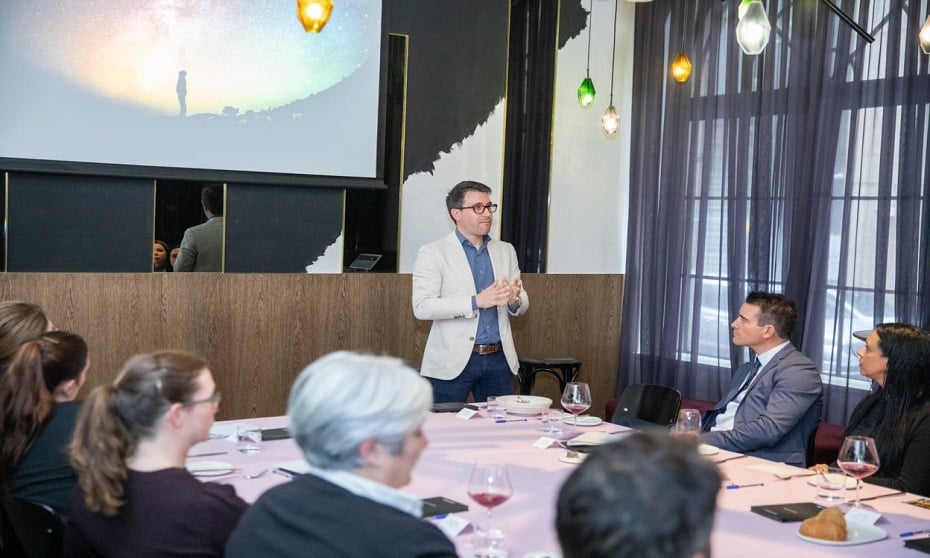
Senior HR, finance and business leaders from major corporations participated in a lively roundtable in Sydney

How can organisations leverage technology to nurture, monitor and grow employees?
The question was one of many discussion points explored recently at the SAP SuccessFactors Executive Roundtable at The Bentley Restaurant in Sydney.
Senior HR, finance and business leaders from major corporations participated in the lively conversation moderated by the News Editor of HRD John Hilton.
The roundtable first heard from Riccardo Pasto, Senior Analyst at Forrester, who discussed the importance of making the business case for streamlining HR.
He referred to Forrester Consulting research that examined the potential return on investment organisations can realise from SAP SuccessFactors HCM solutions.
The Total Economic Impact Study found that a composite organisation experienced benefits of $11,005,505 over three years versus costs of $5,186,681, adding up to a net present value of $5,821,824, with a payback period of six months and an ROI of 112%.
.jpg)
Moreover, the research found interviewed customers that migrated from SAP HCM on-premises software to the SAP SuccessFactors cloud solution had better benefit results.
Pasto also talked about the importance of building a supportive workplace to create loyal workers willing to remain with and advocate for the organisation.
He cited Forrester research which asked employees about the main factors driving loyalty.
“First and foremost, the research found we need a feeling of empowerment to solve problems and challenges at work,” said Pasto
The second factor involves making employees feel recognised for their achievements and effort they put in.
“Think about how your people and systems support this – make people feel recognised for the work that they do and compensate them accordingly,” said Pasto.
“This has to be ongoing. Think about multinational organisations who might have offices in Europe and China: how can they make consistent decisions when it comes to recognising talent and align everybody in the same direction?
.jpg)
Pasto also sees the significance of ongoing coaching and support that is not just onboarding training alone.
“It has to be ongoing throughout the lifecycle of the employees. From start to finish, how can organisations help them grow?”
The roundtable also heard from Rachel Dodds, Customer Speaker and General Manager HR Service Centre & Systems at Broadspectrum.
Dodds spoke about working with the CFO and CEO to ensure HR and business were aligned and the impact the transformation had in the form of cost savings and business benefits.
This is a particularly significant challenge for the company that specialises in infrastructure maintenance services, given it has more than 11,000 full-time and part-time employees in Australia and New Zealand.
Dodds said that one project HR is working with finance and IT on is around recruitment and onboarding which are high priorities for Broadspectrum.
.jpg)
On average, it takes Broadspectrum about 34 days to recruit for a role, 11 days from offer to onboarding and 10 days once onboarding is initiated.
“That’s a significant amount of time and one of the challenges with the finance teams and IT teams is making sure we have these people ready,” said Dodds.
“Without important information being loaded into payroll we can’t pay people. Our task involves looking at how we complete that in a shorter timeframe.”
Working with finance and IT, Broadspectrum’s HR team sought to improve that onboarding experience for their people.
“It’s not just HR alone, there are lots of players in the onboarding program.
These days, it’s crucial to build cross-functional teams,” added Dodds.
.jpg)
“The days of HR being solely responsible for onboarding are long gone - it’s actually HR, IT, procurement and the operations.”
Consequently, it’s vital to bring data to the table and start to have those conversations to help the various functions understand that they all have a role to play in HR processes.
“If you don’t have the data – if you are not collecting it, can’t retrieve it or can’t analyse it then how can you go to your CFO and say, for example, ‘I really want another $100,000 to help fix our onboarding’?
“There are plenty of competing priorities and the reality is you won’t get the money without an improved business case.”